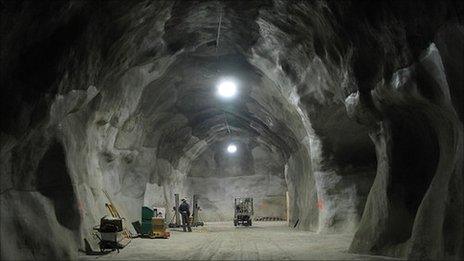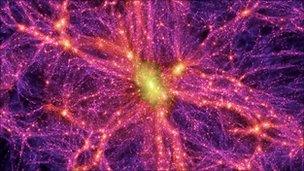Dark matter hunt eyes deeper home
- Published

The dark matter experiment could relocate to a deeper site in Canada's SNOLAB facility
Scientists are looking to relocate an underground experiment searching for dark matter to an even deeper site.
Cosmic rays striking the Earth could completely mask the rare dark matter events sought by the experiment.
Team members want to cut out as much of this cosmic ray interference as possible, even if it means moving the experiment 2km below ground.
This could help them positively identify the particles thought to make up dark matter.
Dr Marek Kos, who is a team member on the Cryogenic Dark Matter Search II (CDMSII) project, outlined details at the International Conference on High Energy Physics (ICHEP) in Paris.
He said the experiment could be relocated from a mine in Minnesota to a deeper facility in Ontario, Canada.
The matter we can see makes up just 17% of matter in the Universe; the remaining 83% is "dark", meaning it does not reflect or emit detectable light.
The existence of dark matter has been inferred through the gravitational pull it exerts on luminous galaxies and stars.
Though scientists have no idea what it consists of, one popular theory is that dark matter is made up of WIMPs (Weakly Interacting Massive Particles).
Supporters of the idea believe a large number of WIMPS pass through the Earth every second. But, because they interact only very weakly with normal matter, detecting them is difficult.
Experiments such as CDMSII measure large numbers of particle interactions in their detectors in the hope of spotting one caused by a WIMP.
CDMSII operates at extremely low temperatures and detects the energy released when particles hit atoms in germanium and silicon crystals within the detectors.
Mystery events
CDMSII is currently housed at the Soudan mine in Minnesota. The experiment resides on the 27th level - some 2,341ft below the surface. The original experiment was located in a tunnel on the Stanford University campus in California.
Dr Kos commented: "If we have another successful run at Soudan, we're planning to go even deeper, possibly - to the SNOLAB in Sudbury, Ontario, in Canada.
"It is at 6,000m water equivalent - a figure that's used to compare it to other experiments - but it's about 2km underground."

Improved detectors should boost the chances of detecting WIMPs from space
Going this deep would help reduce the background signals from cosmic ray muon particles. This effect can only be reduced by moving deeper underground.
Last year, team members made headlines when they reported the detection of two signals which could have come from dark matter particles.
However, writing in the American journal Science, they also reported that the statistical likelihood these were due to WIMPs was low.
Dr Kos, from Syracuse University in the US, told BBC News: "We were critical of those events when we saw them. Discovering WIMPs is a big deal and you've got to be sure you're looking at the right thing."
Bigger and better
Scientists are in the process of installing improved detection equipment at the Soudan mine.
"We're fabricating bigger detectors and some of those are already underground and operational," said Dr Kos.
These will help exclude false positive signals. The detectors pick up two types of particle interactions: electron recoils and nuclear recoils.

Nasa's Fermi satellite has seen no evidence yet for dark matter collisions
WIMPs hitting the detectors are expected to produce nuclear recoils. But certain electron recoils can look like nuclear recoils - these are known as "surface events".
The new detectors are designed to be much better at distinguishing WIMPs from surface events.
Dr Kos said team members were pushing for the new detection equipment to be fully installed by the Autumn, but that there was as yet no firm timescale.
Meanwhile, several other experiments are joining international efforts to hunt for signals from these particles.
One of these is the Large Underground Xenon (Lux) experiment. Like CDMS, this aims to make a direct detection of WIMP particles, but uses different technology. It is being housed underground at the Homestake mine in South Dakota, US.
Meanwhile, Nasa's Fermi Space Telescope is taking a different approach to try to pin down dark matter. It will look for evidence of dark matter "annihilations" in space.
These annihilations are thought to occur when two WIMPs collide, generating gamma-rays which can be picked up by detectors such as those on board Fermi.
However, speaking at ICHEP, Dr Robert Johnson said team members had found no evidence as yet for these events.